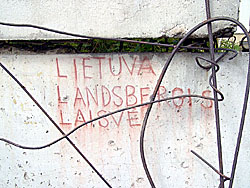Short-short Late-late History
|
| Communism started to soften already in the mid-80:s and the border states started to take
increasingly greater liberties. The, later democratically elected, president Vytautas Landsbergis applied for Lithuania’s
exit from the Soviet Union in 1991. The Soviet law stated that the republics could renounce membership, although
no one had ever though of doing it, as the KGB would most surely shoot him. But because of all the anti-Soviet
undercurrents, this paragraph was about to be scrapped. Landsbergis handed in his application a mere two hours
before the paragraph was scrapped, and had it approved, in accordance with the law. One could say that it was Landsbergis
(backed by the naïve Gorbachev, who thought he could democratizise the Communist party) who finally toppled
the Soviet Union. Although, we mustn’t forget to thank Ronald Reagan for the Star Wars bluff, which drained the
Soviet economy. |
|
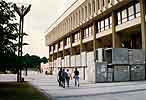
|
In 1991 Michail Gorbachev received the Nobel Peace Prize. Six days later he let
the tanks roll through Vilnius, and a putsch was feared. Lithuania was close to his heart (the part of the heart
marked “One more word, and you’re as good as dead“) because he had been the republic’s former governor. He wouldn’t
let go of the Soviet Union’s granary without a fight. The image shows Nepriklausomybes (Independence Square)
in 1992, with the Parliament House still blocked by concrete bunkers. New attacks were feared all the time. There
were thousands of people around the Parliament every night, with their bodies as the only defence against the Russian
tanks. At the front middle of the house is a memorial to those who sacrificed their lives. |
| Those standing around the square in 1991 were only waiting for the tanks to come rolling all over them, in the
old Soviet way, or that the Alfa Force would parachute down. It is believed that only four members of the Alfa
Force have ever died, plus a fifth who died when the force was deployed to “free” the audience of the Dubrovka
Theatre in Moscow in October 2002 after a group of Chechnyans had taken the whole theatre hostage, demanding an
end to the war in Chechnya Alfa used poison gas and killed some 190 innocents, a lot more than the five killed
by the Chechnyans. Alfa’s only job was to save the president’s face, in this case the ex KGB officer Vladimir Putin,
regardless of methods. Not that there was much of a face to save for this man who so light-heartedly had played
golf while hundreds of sailors died in the Kursk submarine in 2000, and who would only after five days disclose
the composition of the poison gas, when everyone who could complain, was dead for sure. But, as the Chechen leader
had it: “You’re not even showing compassion with your own people, so why would we expect compassion? We came here
to die.” |
|
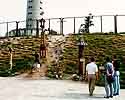
|
But the Red Army made the mistake of fighting in front of open TV cameras, and against
a very determined people. It is rumoured that the US president George Bush postponed the Gulf War for a week, so
that the world would not loose interest i little Lithuania. The image shows the Vilnius TV tower, around which
severe battles were fought, between drugged Russian tank drivers and unarmed civilians. A total of 14 persons were
shot or run over by tanks. We are standing in front of the memorials, the typically Lithuanian “totem poles” with
words of remembrance. |
Pick-nick on an ICBM Silo
|
| A unique image document from the ex-Soviet ICBM base in Telsiai in Lithuania. The base is closed down and deserted
and all the ICBMs have been removed. At the time of this visit in 1997 one family, who would guide people around
for a fee, guarded the base. |
|
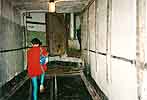
|
In a passage on the way to a missile silo. |
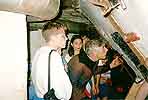 |
A look into the silo, with corrosive fuel and radioactivity. |
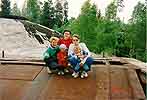 |
On top of the silo. The Soviet signature above all: rust. |
| Of course people have been breaking in and looting the base of all loose items, but still it is easy to understand
the terrible circumstances that the personnel had to live by. Everything very cramped, badly built installations,
loose wires hanging from the roof and ticking, leaking atomic bombs in every hole and corrosive rocket fuel. Also
notice the family sitting on the lid of the ICBM silo, check out the substandard lid and the badly smeared tar
on the concrete dome. The installation decayed like this in only 6-7 years without maintenance. Do you think this
installation would have worked if things had got serious? And where did the Russians dump the rockets? Photo:
Dangira Griksiene. |
|
And then what?
|
| History has been tough with the Lithuanians: one day living, the next day crushed under
tank caterpillars. One day a respected border guard, the next day shot through the head by specially trained murderers
of a Russian terror force. The thousands of unarmed people guarding the Parliament with only their bodies those
fatal days in February 1991, survived only because the tank drivers understood the impossible in just running through
the mass of people. “Too much meat” was the intercepted report on the Russian communication radio link. Then and
there the Lithuanians knew they had won. |
|
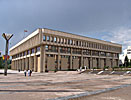
|
The Independence Square is a sunny and peaceful place today, but if you venture
a little beyond the house, the cruel, hard memorials are still there. |
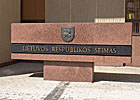
|
The grand sign outside the Parliament. |
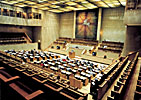
|
Many scandals have been laid bare in this assembly hall, and many a head has been rolling. But there are many traitors
left. |
|
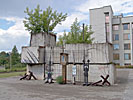
|
The tank stoppers and concrete bunkers are left so than no one should have the shadow
of a chance to forget. The typically Lithuanian wooden sculptures are memorials over those killed during the terrible
night of February 13, 1991. |
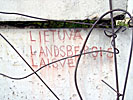
|
LLL: Lietuva Landsbergis Laisve - Lithuania Landbergis Liberty. The words allude to the LLL Group, the group
of hardened politicians around Vytautas Landsbergis that were working untiringly for Lithuania’s independence from
the Soviet Union. |
|
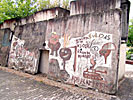
|
“Burokevicius Kvisling“ says one of the concrete plates. It is the Communists Burokevicius and Kardamavicius being
ridiculed. They make fun of the names and mean that the only thing to do with them is to hang them and make beetroot
soup out of them (burokas = beet, kardamonas = cardamom) because they are “KPSS PLATFORM“ i.e. collaborators to
the Soviet Communist party. |

|
One of the memorials show the pictures of the 14 young who were run over by tanks or killed in other ways during
the fight at the TV tower. Below these, are the seven border police who were killed when attacked by Soviet Alfa
troops at the Kaliningrad border, at Medininkai. The eighth one survived, to Soviet’s great regret, and was able
to tell about the crime. |
NATO and the EU 2005
NATO has moved in. This of course made the real Lithuanians happy, those who always hoped for intervention from
the west. Their hopes were crushed many times, such as when it was needed most, during the Partisan war. But finally
it came. The old KGB men are still at power in the giant Russian sham democracy, dreaming about their old bread
basket, but at the moment they can but gnash their teeth at the monstrous cost a new occupation attempt would command.
Go on. Keep gnashing! Rust-proof your submarines in the meantime.
But the cheeky western soldiers probably hadn’t expected the tough welcome they received. Something the tabloids
love reporting about. Like soldiers always do, they tried meddling with the Lithuanian girls, but they got a beating.
And foreign officers driving drunk in the streets get the same treatment as the locals.
Tarybinis metai
When Lithuanians think something is bad or slow or if someone gives bad service, they often say it is “tarybinis”
or like under the “tarybinis metai”. Tarybine means “union“ and the expression means that it’s like in Soviet times,
when everything was bad and no one was interested in working.
“This is a beautiful place. How strange that the Soviets didn’t build a prison or a garbage dump here.” Everyone
agrees that the Soviet Union never did anything positive at all for Vilnius, except that they built the Opera house,
which actually is quite nice and functional.
|
|
My Own Beginning in Lithuania
|
| It all began for me in 1992, when I got the seemingly crazy idea of going to the isolated
Baltics, a place we had only heard about in the weather reports. It was a shocking trip, but it made me see that
there were other parts of the world than the prosperous West, which was all I had seen so far. I made many trips
and the country’s tough destiny got a definite grip on me. At the same time I saw the beauty. In 2001 I decided
to begin my great venture, making this website about Lithuania. |
|

|
We were four literature enthusiasts: me, Ahrvid Engholm, Magnus Odelius and Rolf Strömgren, who used to visit
most Science Fiction conventions around. In 1992, only one year after the Soviet occupant was thrown out, we visited
our first SF convention in our hitherto unknown neighbouring country Lithuania. Four unsuspecting, happy guys took
a boat to Tallinn in Estonia, rented a car and started our life-long love for this unknown country. There was a
lot to discover. |
| SF literature had problems during communism, because it expressed a future other than the one ratified by the Party.
No one wanted to read Communist-ratified SF. When Communism disappeared, the SF clubs mushroomed everywhere in
the eastern bloc. There must have been more mushrooming in Lithuania than elsewhere. There is more information
about Club Dorado and Lithuanian SF here. |
|

|
Our trip through Estonia, Latvia and Lithuania wasn't very adventurous, apart from the navigation being severely
hampered by the lack of road signs and the police force's interesting method of enforcing local speed reductions,
by putting the signs down the ditch and then fining everyone who didn't see them. But we were on the lookout and
were not harmed. SF people are used to beer testing, and the Lithuanian beer was scrupulously tested. Here, the
well-known Swedish SF organiser Ahrvid Engholm is in an intense testing situation. |
| The very first convention we visited was in Kaunas, the country’s
second largest city. We reached our hotel
late in the night, and because the room price was a formidable SEK 3.50 a night we offered to pay the hotel stay.
But no-no, everything was sponsored. |
|
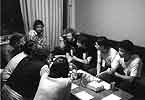
|
The next night the Ukrainians had a room party in a not too well-kept hotel room with only one lamp. It wasn’t
for someone with a weak stomach. The grub was simple. Bang! A substantial can of preserved meat. Bang! Bang! Some
vodka bottles with a tear-off seals (meaning: drink it all) and black, sturdy bread. We had great fun. Drinking
and toasting between us Swedes, Ukrainians and Byelorussians, people who can drink in style. Glasnost, the new
openness had torn down all the old, and here was a world of new contacts. On the side-table is a carton of Russian
kefir, probably for the follow-up party. In the foreground, from left are the backs of a few pioneers: Rolf Strömgren,
Ahrvid Engholm and Violeta Povilionaité, one of the organisers. The picture quality is not the best. It
was made with Soviet 64 ASA film, because my Swedish Kodak roll was quickly used up. |
We also got the time to visit Vilnius and saw a Lithuanian
supermarket. We were heart-broken when we saw the empty shelves, the rust, and the poor people who had to muddle
through anyhow.
The convention was interesting, to say the least. We were probably some of the very few Swedes that had met with
Lithuanians, Ukrainians, Latvians, Russians and other exotic nationals, in those days. To them, we were equally
exotic. I felt strange inside, when during the finishing party I spoke to an elderly lady, who had probably been
around since before Communism. When she discovered I was Swedish, she said in her broken English:
- Sweden! Sweden! We love Sweden! Oh, how I love the “Gösta Berling Saga”! (a well known SF epic saga written
by Selma Lagerlöf, a Swedish national author, sometime in the 30's).
I got a lump in my throat, and I didn't dare to confess that I had only heard of the book title, and not even seen
the film. I, the uneducated rawhide. A certain measure of reverence presents itself in front of this people which
has been suffering so much. |
|
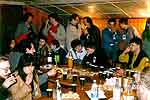
|
Later, Club Dorado in Vilnius has arranged many conventions, and I try to be present at all of them. The very last
picture shows a very high-spirited moment at the after-party of the 1996 Lithuanicon. It may look just like any
party, but the fact is that in this picture you can see people from Lithuania, Sweden, Poland, Ukraine, England,
Rumania, Latvia, Switzerland and Finland. Finally, Lithuania was open to the world. |
|
